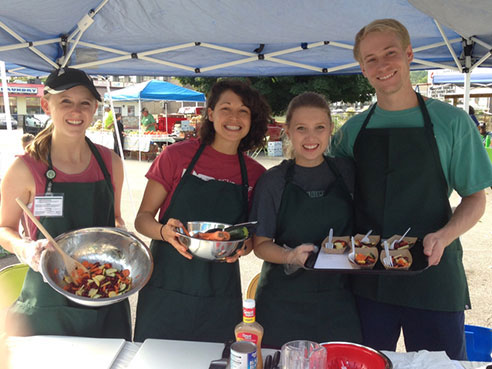 UAB medical students demonstrate their Rainbow Vegetable salad, a healthy and low cost meal, at a Birmingham Farmers Market.Medical students at the University of Alabama at Birmingham are trading their textbooks and scalpels for fresh produce and chef knives to prove that healthy, affordable meals can taste good too.
UAB medical students demonstrate their Rainbow Vegetable salad, a healthy and low cost meal, at a Birmingham Farmers Market.Medical students at the University of Alabama at Birmingham are trading their textbooks and scalpels for fresh produce and chef knives to prove that healthy, affordable meals can taste good too.
Students from the UAB School of Medicine have spent Saturday mornings in September at the East Lake Farmers Market in Birmingham, preparing and serving samples of nutritious and affordable dishes each week to showcase the benefits of healthy eating and its impact on a person’s health.
“There’s a misconception that you aren’t able to eat healthy at an affordable price, and that healthy food tastes bad,” said Jenny Stevens, a fourth-year M.D./MPH student from Jackson, Alabama, who participated in the cooking demonstrations earlier this month. “One thing we really want to show is that eating healthy isn’t a punishment — you can have food that tastes really good, is affordable and is good for you.”
Coordinated through the school’s Office of Service Learning, the idea originated last spring as the winner in the first Service Learning Celebration, in which students presented ideas for more service learning opportunities to address social determinants of health they are likely to see in their medical careers — factors like poverty, education, health literacy, and housing/homelessness.
“We heard from students that they wanted more content on nutrition as an expansion of what they learn in their Fundamentals of Medicine courses during the first year of medical school,” said Kristin Boggs, MSW, director of the Office of Service Learning in the SOM. “We hope this experience will give our students a chance to interact with individuals from different backgrounds and benefit people in the East Lake community."
The office partnered with UAB School of Health Professions alumna Rosemary Dallam, a local registered dietitian and culinary educator, for a two-hour crash course on food preparation and the nutritional benefits of certain foods. Each recipe came from the federal Supplemental Nutrition Assistance Program website, and has a nutrition-based educational component, such as using foods that are low in sodium or fat.
| “We heard from students that they wanted more content on nutrition as an expansion of what they learn in their Fundamentals of Medicine courses during the first year of medical school.” |
“The great thing about these recipes is that they didn’t require a ton of ingredients or a great degree of skill — just chop up these vegetables and you’re ready to go in about 10 minutes,” said Madeline Dills, a second-year medical student from Hoover.
Dills, who participated at the farmer’s market earlier this month with Stevens, Milza Opper, an M.D./MPH student from Alabaster, and Dylan Nichols, a medical student from Tuscaloosa, says the students passed out more than 30 samples of their Rainbow Vegetable Salad dish and had several people approach them for copies of the recipe and to get more information.
“We had a lot people come up and talk to us about how they cook certain foods and asking us questions about who we were and what we were doing there,” Opper said. “There was a lot of interest in both the cooking side and the medical and nutritional information, which was really great to see.”